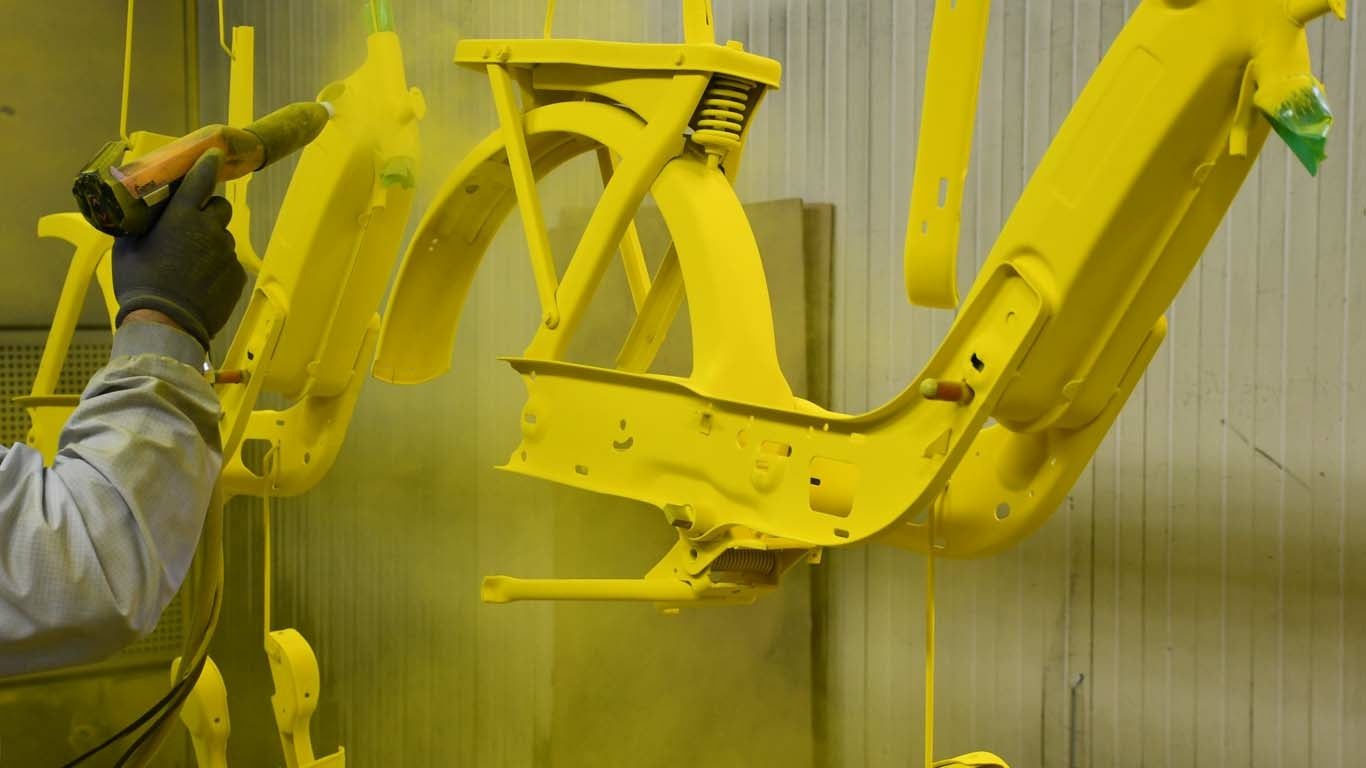Powder coatings are organic coating materials that, after application, are melted or chemically crosslinked by heat on the coated surfaces. This creates a continuous, well-adhering coating. Powder coatings, like paints in general, have two essential functions: decorative and/or functionally protective. The powder coating layer has the following functions:
- a decorative one in which the powder coating gives the surface colour, shine, flow/structure and
- a functional function regarding mechanical stress, corrosion resistance, weathering, chemical resistance and electrical insulation.
The composition of powder coatings
Compared to powder coatings, conventional wet coatings consist of a three-component system: binder/film former, pigments, and solvent. The solvents are crucial for the properties and production of the coating. Powder coatings are essentially a two-component system:
- Binders (resins, hardeners, accelerators)
- Pigments and dyes
To further change the properties of powder coatings, additional substances such as fillers and additives are used during production.
Binder/film former
The largest part of the composition is made up of the binders, which also form the paint film that envelops all other components in the powder coating.
Binders are divided into thermosets and thermoplastics. Today, electrostatic powder spraying (EPS) primarily uses thermoset binders, while thermoplastic powder coating systems are applied using the fluidized-bed coating process.
resins
- polyester
- Epoxy
- Acrylic
- Glycidyl acrylate
|
Comparison between binder systems for powder coatings |
||
|
Resin base |
Advantages |
Disadvantages |
|
Epoxy |
|
|
|
Epoxy-polyester mixture (hybrids, EP-PE) |
|
|
|
polyester |
|
|
|
Polyurethan |
|
|
|
acrylate |
|
|
Pigments and dyes
Pigments enable the opaque, colorful appearance of powder coatings. They must meet various requirements to be used, such as thermal resistance during baking or compatibility with other powder coating components. A general distinction is made between inorganic and organic pigments. The latter play a significant role in the production of intense, strong colors (red and yellow) and generate high production costs due to the limited selection of raw materials. Functional pigments are also used, which predominantly consist of anti-corrosive pigments, such as zinc phosphates. The goal here is to achieve additional protection for the substrate.
Unlike the pigments in powder coatings, dyes are soluble, which creates a translucent color impression after firing, as is the case with glazes. It should be noted that the substrate and the thickness of the glaze are crucial for the final color result. A disadvantage of using dyes is their lower weather resistance.
Additive
There are numerous additives that modify and/or enhance various powder properties. Examples include leveling agents, degassing agents, matting additives, structural and texture additives, and many more. UV absorbers are also added to clearcoat powder coatings. The overall concentration of these additives is limited to 0.1 to 1%, as an overdose would have the opposite effect.
Fillers
The fillers usually consist of natural minerals, such as barite, feldspar, chalk, or quartz sand. These impart the powder coating film its special properties and influence macroscopic effects on the coating film.
Production of powder coatings
To disperse (mix) the pigments, powder coatings must be produced in the "liquid phase." Simple mixing would not be sufficient; the consequences would be disruptions in the film structure and separation during processing. This would prevent a homogeneous color appearance on the surface, as is common with metallic powder coatings produced using the dry-blend or bonding process.
Production steps
- Mixing and homogenizing the raw materials
- Dispersing the pigments in the extruder
- Cooling of the powder mass (extrudate)
- Grinding, sieving and filling
The binder is melted through a continuous application of mechanical and thermal energy, changing its viscosity from solid to viscous. The pigments (and/or additives) are then "worked" into the binder in the extruder using high pressure. The viscous, hot powder mass leaves the extruder and is rolled out evenly via a conveyor belt system (see photos), allowing the temperature to drop quickly. The resulting "powder sheets" are then crushed, ground, sieved, and packaged.


The images show part of the manufacturing process. The first photo shows the powder mass being pressed out of the extruder and rolled out on the conveyor belt for cooling. The second photo shows the crushed powder plates, which are then ground into powder.
Further developments in powder coatings
Low-temperature curing powder coatings (NT powder)
Thanks to the advancement of powder coating systems, curing temperatures can be reduced to 140 °C or lower. This opens up further possibilities for processing various substrates, such as wood, glass, or plastics. Powder coatings are used economically in the MDF and plastics industries, where they meet decorative requirements. There are limitations regarding the color selection and degree of matting, so matte products cannot be offered.




